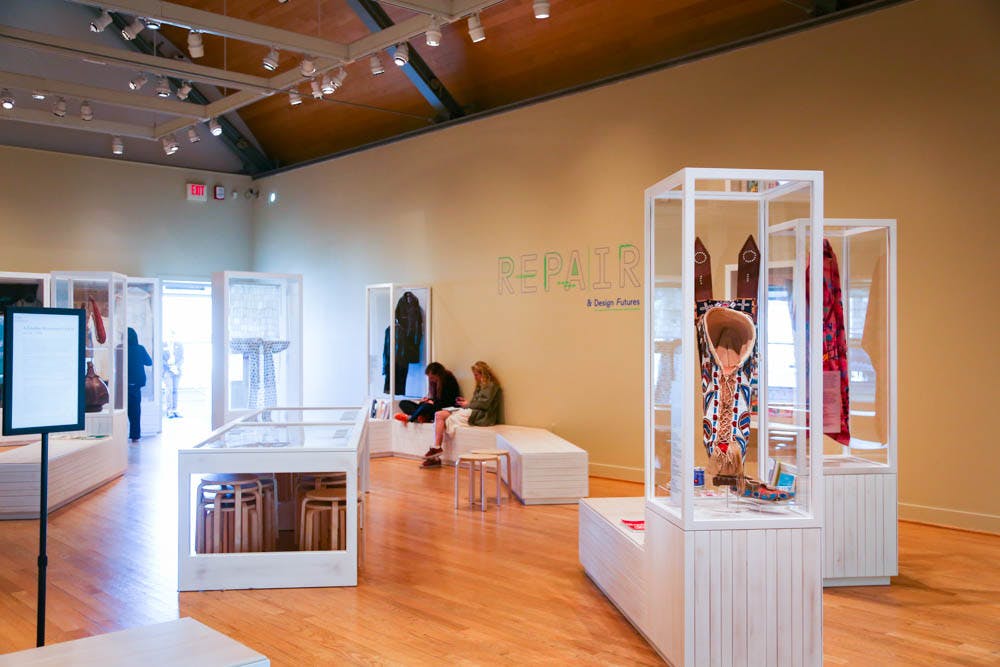The Rhode Island School of Design Museum’s latest exhibition, “Repair and Design Futures,” opened its nine-month run Oct. 5. The exhibition focuses on the theme of repair as a “material intervention, metaphor and call to action,” wrote Kate Irvin, RISD Museum curator of costumes and textiles in the installation’s opening wall text.
The exhibit comprises clothing and textiles, quilts and appliqués, embroidery pieces and assemblages, each of which contains tears and repairs of varying size. Each piece quietly contributes to the exhibition’s wider theme, featuring concealed stitches or carefully placed patches.
Irvin thought about the theme of repair — both the literal act and its metaphorical value — for many years before bringing this exhibition to fruition, she explained. The exhibition connects pieces from the RISD Museum’s permanent collection with a selection from the Haffenreffer Museum of Anthropology.
“It was important to me to really have a wide geographic as well as chronological range of objects,” Irvin said.
Irvin highlighted “Work Coat (Noragi),” a cotton, indigo-dyed, patched and repaired Japanese coat by an unknown maker. She emphasized that she started thinking more carefully about repair after witnessing the interaction between the coat and current RISD students “who are making things in a world where we actually … already have too many things,” she said. She found this conjunction especially intriguing within the context of the “world today — which is a … very fragmented world, environmentally and socially,” she added.
The exhibition extends into the Museum’s Café Pearl, where “Lessons from Jacob Lawrence” — a collaboration between artist and designer Christina Kim, improvisational quilter Laverne Brackens and artisans at the Shuktara Trust, an Indian charity benefiting homeless children with disabilities — hangs on the large wall facing the Benefit Street entrance. The final product of a project which began in 2004, the exhibit comprises 12 quilts — an expanse of color and stitches. The quilt parses together scraps of old saris and textile from Kim’s clothing and houseware company, using improvisational quilting techniques from several generations of black American quilt-makers.
“Christina Kim has always been … very committed to sustainability and ethical practice,” Irvin said, adding that “Lessons from Jacob Lawrence” focused on “keeping some traditions that are beginning to fall away, alive,” she added.
In the Donghia Costumes and Textiles Study Center down the hall in the Museum, “Repair and Design Futures” continues with “Lost in the Museum,” an exhibit curated by Anna Rose Keefe, the costume and textiles department conservation assistant. “Lost in the Museum” displays a series of textiles and clothing pieces that were unlabeled and forgotten in the RISD Museum’s inventory boxes for years, rendering them inaccessible, Keefe explained.
Keefe pulled out every object that had no established provenance, comparing the physical objects to the inventory records. “Certainly the pieces that are there — they are kind of flashy, there is a lot of metallic thread, there’s a lot of embroidery techniques, things that are really distinctive,” she said. “I was able to do some research, identify the techniques, and then cross-reference” the inventory, she added.
This process is what grounds “Lost in the Museum” in the practice of creating objects, Keefe said. “All of the rectifications that I did were made possible by understanding how objects come together,” she said, emphasizing that this exhibition is well-suited to RISD students, who are inspired by pieces like those displayed.
The exhibition came together during the months following the 2016 presidential election, Keefe said. “I do think in a lot of ways people are sort of feeling broken right now, and we are confronting those feelings,” she said, adding, “I think it’s good to think about a path forward, to conceptualize solutions, because right now it feels like we have a lot of problems.”
A series of lectures, programs and workshops will accompany the exhibition throughout the academic year. “It’s also not just an exhibition — it’s really meant to be a space for interdisciplinary programs,” Irvin said, adding, “The whole idea is that these are objects that will, I hope, touch on conversation that will lead to thought and practice in many disciplines beyond the … apparel and textile medium,” Irvin added.





